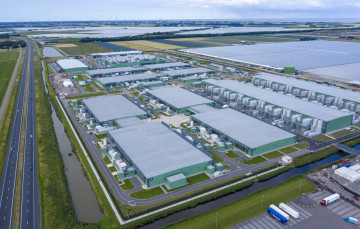There’s no question that data centers have complex operations that include numerous hazardous activities and spaces. These operations are further complicated by the nature of data center design and the myriad of stakeholders that play unique roles in daily operations, securing, upgrading, and maintaining. These data centers hold the equipment and processes upon which global businesses, educational systems, and the general public rely.
Antea Group co-hosted our first EHSxTech event specifically focused on data center EHS challenges with STACK Infrastructure in Virginia where we were joined by Data Center EHS professionals from more than 13 technology companies representing hyperscalers, colocation providers, and enterprise owner/operators.
The lively conversations, presentations, and panel discussion focused on EHS challenges specific to data centers including keeping employees, contractors, sub-contractors, vendors, and visitors safe throughout initial construction, operations, retrofit, and upgrade phases of the data center lifecycle. Some of the key discussion points included the challenges of supplier and vendor management, the utilization of EHS Management Systems, and overcoming biases in incident investigation.
Tying together the various discussions throughout the event was one common goal: navigating complex EHS challenges in data centers to create a safer, healthier working environment for all.
Vendor Management and Contractor Safety
We kicked off the event with a panel discussion on the challenges of multi-employer worksites and a group discussion on vendor and contractor management.
In any multi-employer worksite, you run into complex EHS challenges. As an EHS professional, communication and early involvement were identified as two key components to successfully manage these worksites. Ideally, EHS engagement should begin during initial contracting efforts. Setting clear expectations for employee safety should occur early in the business relationship and is key for avoiding conflict and confusion as more and more stakeholders engage at a given facility.
A comprehensive EHS supplier and vendor management program was also identified as a crucial element in ensuring safety over the data center operations lifecycle. Understanding a contractor or partner’s safety history, processes, and procedures allows for the identification of potential unsafe practices prior to vendor onboarding and project initiation, affording an opportunity for proactive risk mitigation.
Discussions with attendees at the event revealed a wide range of contractor management maturity levels. Some companies described highly mature vetting processes for contractors, including dedicated teams for contractor vetting, while others leveraged small internal teams or external vendors to evaluate contractor programs, procedures, and past performance. A commonly overlooked group of contractors is those providing low-risk services such as vending and janitorial support. Given the complex nature of data centers, the inclusion of these vendors in the contractor safety program is seen as a best practice that everyone should consider.
Another major challenge involves vetting and auditing second and third-tier subcontractors where visibility of past performance metrics is piecemeal, at best. To tackle this issue, participants discussed the importance of continually updating and enforcing contractual language to ensure general contractors maintain oversight of these subs, thereby closing any potential contractual loopholes or gaps in communication during the introduction of new subcontractors onsite.
These multifaceted challenges underscore the complexity of supplier and vendor management within data centers, requiring nuanced strategies and continuous improvement efforts.
In addition to vetting contractors, EHS leaders are responsible for overall contractor safety. Ensuring the safety of contractors is essential to prevent accidents, protect the data center's operations, and comply with legal and regulatory requirements. Here are the priority areas of focus and best practices the attendees discussed:
- Prequalification of contractors: Establish rigorous prequalification criteria for contractors, including maintaining and providing safety records, certifications, and training.
- Contractor Orientation and Training: Provide comprehensive safety orientation for all contractors before they start working at a data center and ensure they receive training on data center-specific safety procedures, emergency protocols, and facility rules. It is crucial that all contractors understand that any onsite personnel within their subcontractor network are required to receive this orientation and training prior to beginning work. One practice to “catch everyone”, prior to beginning work was tying facility access directly to completing the onboarding training.
- Safety Equipment and Personal Protective Gear: Ensure contractors are provided with necessary safety equipment and personal protective (PPE) gear, and ensure they are trained in their proper use. PPE should be provided by the primary employer. Also, verify regular inspections and maintenance of safety equipment are completed
- Documentation and Record-Keeping: Maintain accurate records of contractor safety training, certifications, incident reports, and safety compliance. Ensure all documentation is up to date, and easily accessible.
Following our discussion on Contractor Management, the EHSxTech group viewed a virtual presentation on incident investigation best practices and prevention of cognitive bias.
Incident Investigation: Preventing Cognitive Bias
Incident investigation is a complex process that requires careful consideration of cognitive biases that can influence outcomes. Cognitive biases are often automatic and unconscious, shaping how individuals select and process information. Jennifer Serne-Allen, Safety Professor at Central Washington University and Accident Investigation and Human Factors Researcher shares Hollnagel’s concept of “What you look for is what you find”. This can lead to shortcuts that simplify decision-making but may also result in biases like the anchoring effect, confirmation bias, and fundamental attribution error.
When conducting incident investigations, it’s important to keep in mind the potential biases in each investigation method. Below are some examples of common ways investigation methods can be biased:
- Checklists are a tool often used in incident investigations which, when worded in a certain way and used under pressure, can inadvertently introduce biases.
- Eyewitness testimony is vulnerable to memory distortions and suggestions during interviews.
- The "5 Whys" or the "5 Blames" approach can introduce biases and oversimplify causal chains of events.
- Root Cause Analysis (RCA) can be influenced by initial hypotheses.
To mitigate these biases, training on cognitive bias awareness is essential. It's crucial to recognize that we often notice bias in others more than in ourselves. “One strategy to combat bias is to list out reasons why your original hypothesis might be wrong,” suggested Serne-Allen. Another approach to consider is instead of asking "Why," investigators can focus on asking "How" to understand the conditions that allowed an event to occur. Using diverse investigation teams can help uncover a more comprehensive perspective on incidents. These strategies can enhance the quality and objectivity of incident investigations in data centers and ultimately improve health and safety practices.
To wrap up the event, attendees discussed EHS Management Systems and the ever-present challenge of lone work in data centers.
Utilizing EHS Management Systems
At the beginning of our event, it became evident that a majority of attendees already had some form of Environmental, Health, and Safety Management Systems (EHSMS) in place, but many of these systems were not necessarily aligned with ISO standards.
Several participants explained that they felt the need to establish a solid safety foundation before pursuing ISO alignment, emphasizing the importance of success in building that foundation or gradually moving towards ISO compliance. Notably, the lack of ISO alignment was cited as a challenge for those seeking contracts with public sector customers.
Many participants mentioned transitioning away from tracking incident rates and instead focusing on internal safety assessments and incident reporting to provide a more comprehensive view of their safety processes and metrics, particularly for customers who specifically request incident data. While some companies, driven by European clients, were pursuing ISO 14001 certification, the consensus was that unless there was a customer-driven need, many participants were concentrating on establishing strong safety management foundations that could align with ISO standards in the future. This pragmatic approach highlights the evolving nature of EHSMS implementation in data centers.
Check out our webinar on implementing EHS Management Systems here.
The On-Going Challenge of Lone Work in Data Centers
Lone work is very common within data centers and continues to be an important topic of discussion due to the 24x7 nature of data center operations. However, even though it is a standard practice across the industry lone work at data centers still comes with risks. Without a partner or someone to supervise them, a lone worker has to be extra careful and hyper aware to stay safe. Data centers can feel like a low-risk environment, however, they pose life-threatening hazards such as falls, electric shock, medical emergencies, and more. All of these hazards become even concerning when there’s no one else around to respond, in the event of a fall or medical emergency. That’s why it’s so important to identify lone worker risks and to create a detailed lone worker policy.
Wearable technology is one option in the journey to help keep lone workers safer. For example, devices that monitor a worker’s vital signs such as smart helmets, safety vests, and smartwatches, can help in the event of a medical emergency. Some of these devices also offer tracking information, so an EHS professional can tell exactly where a lone worker is in a data center, where they’re moving to, and if something is wrong.
Several participants shared how they have made efforts to adopt wearable technologies and software solutions, however, they continue running into barriers and obstacles that have prevented the adoption of a solution across all sites. These barriers have included security concerns, impracticability of poor cellular/internet connectivity within certain areas of the data centers, high costs, incompatibility with existing software and poor employee adoption.
Learn more about lone work in data centers here.
Conclusion
As demand for data centers continues to grow, developing robust EHS programs will only become more important. Each stage of the data center lifecycle, from new builds, expansions, retrofits and upgrades to ongoing operations, presents unique challenges for EHS professionals. We’re grateful for our EHSxTech community where EHS professionals are able to come together to address these challenges by collaborating, brainstorming and working together to create a safer, healthier, more sustainable approach to data center operations. Once again, a huge thank you to all our participants and to our host, STACK Infrastructure!
Interested in joining our next EHSxTech? Learn more here.
Want more news and insights like this?
Sign up for our monthly e-newsletter, The New Leaf. Our goal is to keep you updated, educated, and even a bit entertained as it relates to all things EHS and sustainability.
Have any questions?
Contact us to discuss your environment, health, safety, and sustainability needs today.







